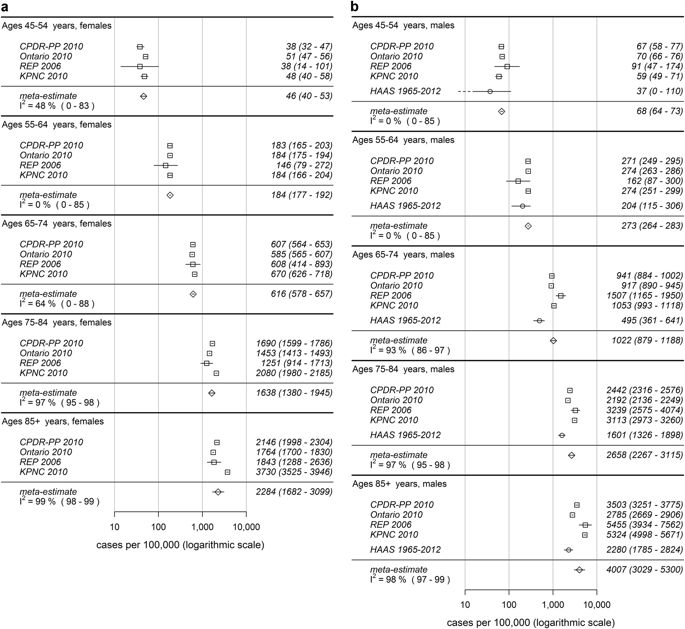npj Parkinson's Disease ( IF 6.7 ) Pub Date : 2018-07-10 , DOI: 10.1038/s41531-018-0058-0 C. Marras , , J. C. Beck , J. H. Bower , E. Roberts , B Ritz , G. W. Ross , R. D. Abbott , R. Savica , S. K. Van Den Eeden , A. W. Willis , CM Tanner

|
Estimates of the prevalence of Parkinson’s disease in North America have varied widely and many estimates are based on small numbers of cases and from small regional subpopulations. We sought to estimate the prevalence of Parkinson’s disease in North America by combining data from a multi-study sampling strategy in diverse geographic regions and/or data sources. Five separate cohort studies in California (2), Minnesota (1), Hawaii USA (1), and Ontario, Canada (1) estimated the prevalence of PD from health-care records (3), active ascertainment through facilities, large group, and neurology practices (1), and longitudinal follow-up of a population cohort (1). US Medicare program data provided complementary estimates for the corresponding regions. Using our age- and sex-specific meta-estimates from California, Minnesota, and Ontario and the US population structure from 2010, we estimate the overall prevalence of PD among those aged ≥45 years to be 572 per 100,000 (95% confidence interval 537–614) that there were 680,000 individuals in the US aged ≥45 years with PD in 2010 and that that number will rise to approximately 930,000 in 2020 and 1,238,000 in 2030 based on the US Census Bureau population projections. Regional variations in prevalence were also observed in both the project results and the Medicare-based calculations with which they were compared. The estimates generated by the Hawaiian study were lower across age categories. These estimates can guide health-care planning but should be considered minimum estimates. Some heterogeneity exists that remains to be understood.
中文翻译:

北美帕金森氏病患病率
对北美帕金森氏病患病率的估计差异很大,许多估计是基于少量病例和区域性亚人群。我们试图通过结合来自不同地理区域和/或数据源的多研究采样策略的数据来估计北美帕金森氏病的患病率。在加利福尼亚州(2),明尼苏达州(1),美国夏威夷州(1)和加拿大安大略省(1)进行的五项单独的队列研究根据医疗保健记录(3),通过设施进行主动确认,大型人群,和神经科实践(1),以及人群的纵向随访(1)。美国医疗保险计划数据提供了相应区域的补充估计。使用我们来自明尼苏达州加利福尼亚的特定年龄和性别的元估计,以及从2010年开始的安大略省和美国人口结构,我们估计≥45岁的人的PD总体患病率为572 / 100,000(95%置信区间537-614),其中美国有680,000≥45岁的人根据美国人口普查局的人口预测,到2010年,该数字将增加到2020年的930,000和2030年的1,238,000。在项目结果和与之比较的基于Medicare的计算中,也观察到流行率的区域差异。夏威夷研究得出的估算值在各个年龄段中均较低。这些估算值可以指导医疗保健计划,但应视为最低估算值。存在一些尚待理解的异质性。我们估计,≥45岁人群的PD总体患病率为100,000 / 100,000(95%置信区间537-614),2010年美国有680,000≥45岁年龄段的个人,这一数字将上升到根据美国人口普查局的人口预测,到2020年约为930,000,到2030年约为1,238,000。在项目结果和与之比较的基于Medicare的计算中,也观察到流行率的区域差异。夏威夷研究得出的估算值在各个年龄段中均较低。这些估算值可以指导医疗保健计划,但应视为最低估算值。存在一些尚待理解的异质性。我们估计,≥45岁人群的PD总体患病率为100,000 / 100,000(95%置信区间537-614),2010年美国有680,000≥45岁年龄段的个人,这一数字将上升到根据美国人口普查局的人口预测,到2020年约为930,000,到2030年约为1,238,000。在项目结果和与之比较的基于Medicare的计算中,也观察到流行率的区域差异。夏威夷研究得出的估算值在各个年龄段中均较低。这些估算值可以指导医疗保健计划,但应视为最低估算值。存在一些尚待理解的异质性。根据美国人口普查局的人口预测,2010年美国将有4000岁以上45岁以上PD的人,到2020年,这一数字将增至约930,000,到2030年将增至1,238,000。在项目结果和与之比较的基于Medicare的计算中,也观察到流行率的区域差异。夏威夷研究得出的估算值在各个年龄段中均较低。这些估算值可以指导医疗保健计划,但应视为最低估算值。存在一些尚待理解的异质性。根据美国人口普查局的人口预测,到2010年,美国将有000名年龄≥45岁的PD患者,到2020年,这一数字将上升至大约930,000,到2030年将达到1,238,000。在项目结果和与之比较的基于Medicare的计算中,也观察到流行率的区域差异。夏威夷研究得出的估算值在各个年龄段中均较低。这些估算值可以指导医疗保健计划,但应视为最低估算值。存在一些尚待理解的异质性。夏威夷研究得出的估算值在各个年龄段中均较低。这些估算值可以指导医疗保健计划,但应视为最低估算值。存在一些尚待理解的异质性。夏威夷研究得出的估算值在各个年龄段中均较低。这些估算值可以指导医疗保健计划,但应视为最低估算值。存在一些尚待理解的异质性。











































 京公网安备 11010802027423号
京公网安备 11010802027423号